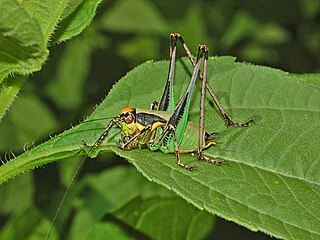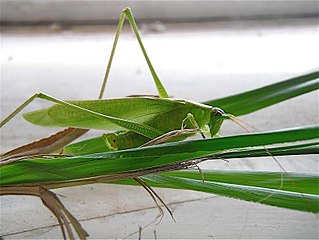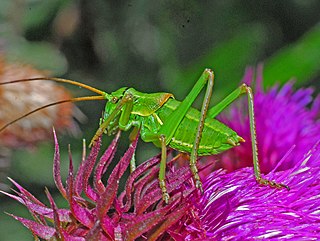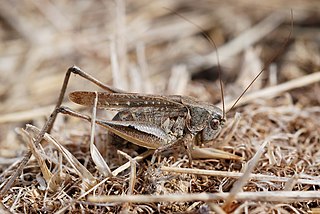
Insects in the family Tettigoniidae are commonly called katydids, or bush crickets. They have previously been known as "long-horned grasshoppers". More than 6,400 species are known. Part of the suborder Ensifera, the Tettigoniidae are the only extant (living) family in the superfamily Tettigonioidea.

Gryllinae, or field crickets, are a subfamily of insects in the order Orthoptera and the family Gryllidae.

Roesel's bush-cricket, Roeseliana roeselii is a European bush-cricket, named after August Johann Rösel von Rosenhof, a German entomologist.

Paraneoptera or Acercaria is a monophyletic superorder of insects which includes four orders, the bark lice, true lice, thrips, and hemipterans, the true bugs.

Conocephalus melaenus, sometimes known as the black-kneed conehead or black-kneed meadow katydid is a species of Tettigoniidae found in China, Taiwan, Japan, Nepal, India, Indo-China and western Malesia.

Eupholidoptera chabrieri is a species of katydid belonging to the subfamily Tettigoniinae.

Conocephalus fuscus, the long-winged conehead, is a member of the family Tettigoniidae, the bush-crickets and is distributed through much of Europe and temperate Asia. This bush-cricket is native to the British Isles where it may confused with the short-winged conehead. These two species are phenotypically similar; however, the distinguishing factor between the two is the fully developed set of wings the long-winged conehead possesses that allows for flight. In the short-winged coneheads the hind wings are shorter than the abdomen, causing the wings to be vestigial and the species is incapable of flight. For this reason it is hard to discriminate between the two species during the early stages of their life cycle before the wings have fully developed. The colouration of the conehead is typically a grass green with a distinctive brown stripe down its back, though there are some brown phenotypes.
Panoploscelis is a genus of very large insects belonging to the true katydid tribe Eucocconotini, which is a subfamily of the katydids. Like the other members of the suborder Ensifera, Panoploscelis are part of the insect order Orthoptera, which also contains crickets, grasshoppers and locusts. Members of this genus are among the largest katydids of the Neotropics.

Antaxius pedestris is a species of "katydids crickets" belonging to the family Tettigoniidae. It was originally described by Johan Christian Fabricius under the scientific name of Locusta pedestris.
Orchelimum gladiator is a species of katydid that has the common names gladiator meadow katydid and gladiator katydid.

Scudderia texensis is a katydid commonly known as the Texas bush katydid.

Conocephalus fasciatus, the slender meadow katydid, is a species of katydid of the family Tettigoniidae that is native to the United States and Canada.

Orchelimum vulgare, otherwise known as the common meadow katydid, is a species of Orthoptera found in the central and eastern regions of North America. They are active from mid summer to fall.
Conocephalus attenuatus, the long-tailed meadow katydid or lance-tailed meadow katydid, is a species of meadow katydid in the family Tettigoniidae. It is found in North America.

Conocephalus brevipennis, the short-winged meadow katydid, is a species of meadow katydid in the family Tettigoniidae. It is found in North America and the Caribbean.
Alinjarria elongata, commonly known as the territory imitator, is a species of bush-cricket from tropical northern Australia. The common name is derived from the fact that the species was at first thought to be a member of the genus Hemisaga until it was realised that its unique characteristics warranted placing it in a new genus.

Caedicia simplex is a species of bush cricket, native to New Zealand. It is also found in Australia.

Ephippiger terrestris, common name Alpine saddle-backed bush-cricket, is a bush cricket species belonging to the family Tettigoniidae, subfamily Bradyporinae.

Erechthis levyi, the blue-faced katydid or Eleuthera rhino katydid, is a katydid found in The Bahamas. Currently, it is described from specimens collected only on the island of Eleuthera. They are light brown in color throughout the body, but exhibit a bright turquoise-blue face and bear a prominent spine on the vertex of the head between the eyes, hence the common names. It is tentatively considered an endemic species to The Bahamas, as no specimens are recorded from Cuba or Hispaniola, where other Erechthis species occur. The species was named in honor of Leon Levy, a prominent Wall Street financier and philanthropist who spent much time on Eleuthera and was an avid admirer of the island's flora and natural beauty.

Platycleis grisea is a European species of bush crickets described by Fabricius in 1781. It is the type species of the genus Platycleis and therefore the tribe Platycleidini. This species is recorded from mainland Europe and northern Africa.
















